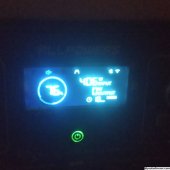Dumb question #1: can panels that are greater than 12V be used with other components (battery, inverter) that are 12V? (Is this one of the functions of the charge controller, stepping down the input?)
That's exactly what an MPPT controller does. It's basically a DC-DC converter that can take (for napkin math) 90v of solar panel DC and convert it to the 14v that your batteries like. Since Wats = Volts x Amps if your panels are putting 5a into the controller at 90v that's 450w. Since your battery only wants 14v, that would be 32a coming out of the controller into the batteries.
A cheapie PWM controller works slightly differently where it just dumps anything over the voltage you need into the aether as waste heat, so those 90v and 5a coming in are only 14v and 5a coming out. That's a HUGE waste of potential power.
Dumb question #2: can batteries of different type / chemistry be connected in the same set-up? It makes sense what
@Rednecktek said above about starting with cheaper components, which is making me think I might start with something other than LiFePO4, though in the long run that is the type I would want to use. So, I could end up with two different batteries.
You
Can, but it's not good practice. If you mix & match chemistries you have to go by the lowest common denominator. So if you were wanting to mix Lead Acid (12.8v) with LFP (14.2v) you'll either never fill your LFP or you'll burn up your lead acid. The best thing you can do is to drop the lead acids off when you are ready to step up to LFP, or go straight to LFP since it's a LOT cheaper nowadays and is worth it if you can afford the up-front difference.
Regarding panel selection, whichever manufacturer I go with, I'm hoping to stick with smaller / lighter panels, because my ideal location (garage roof) is shaded by the main house when the sun is lower in the sky. (I'm at 39 degrees N latitude.) So, I'd like to be able to move the panels around to find the best location from time to time, perhaps even within the day, to take advantage of a good day.
More trips with small panels is better than multiple moves with 60lb panels for sure, although you'll be getting sick of that pretty quickly and be looking at where you can stick them and leave them.
@Solarcabin Channel , you've got a good idea of my application: I'll be charging batteries for lawn and hand-held power tools, nothing too crazy. I'd also like to run some other loads: lights, fan, dehumidifier, and the garage door itself. (That last one is actually high priority as that is the only access to the garage, so when we have a utility outage I'm SOL.)
The dehumidifier and garage door are going to be data points you'll want because the startup surge on the garage door motor is going to need to be accounted for and the dehumidifier tends to be a pretty high draw and runs for a long time so that's a lot of battery power to plan for.
The other part of the equation is time. Sure, your fan draws 50w which isn't a lot, but if you have it running for 10 hours that's 500 watt-hours which is about half of a standard 100Ah LFP battery or the entirety of a 100Ah lead acid just for the fan. Then you want to charge batteries and turn on a light and open the garage door on top of that? Battery capacity adds up quick and while you're finding space for all these batteries and putting together all the required bits and bars and wires to keep everything in balance, it makes rolling your own batteries look a lot more attractive.
To get a better idea of the load, I'll check out the usage on the items listed above. I will check out the specs printed on each device, and is it worth it to buy a
gadget to measure actual load?
Yes, those are really handy especially for the aforementioned dehumidifier and door opener as well as the running load over time of things that will be on for a while like lights and fans and battery chargers.
Fortunately there doesn't seem to be anything on the list that's going to require a huge inverter to supply which is a good thing. I suspect that once you get your power audit underway that a 1200-1500w inverter will probably be enough.



